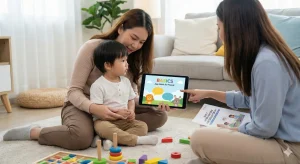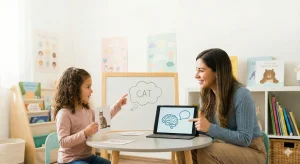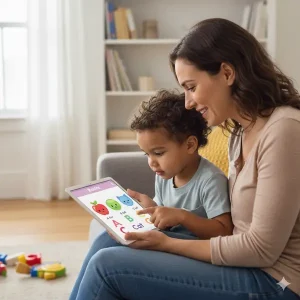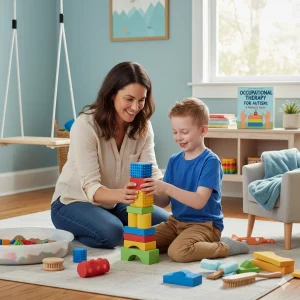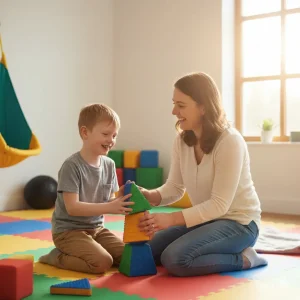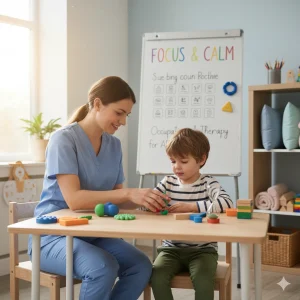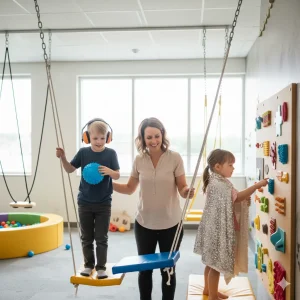Early Intervention & OT for 3-Month-Old Sensory Growth
By Wellness Hub
Last Updated: October 13, 2025
The first few months of your baby’s life are a remarkable time of rapid growth and learning. Their tiny body and brain are building the foundation for movement, attention, and connection. This is also when sensory development in infants happens at lightning speed — they start to notice faces, track movement, lift their heads, and respond to your voice.
But what if your 3-month-old isn’t quite meeting these little milestones yet? Maybe they resist tummy time, struggle to hold their head up, or don’t follow toys with their eyes. These early signs don’t mean something is “wrong,” but they do tell you it’s time to pay closer attention.
That’s where early intervention and occupational therapy 3 month old support can make a powerful difference. With gentle, play-based activities, occupational therapists help babies strengthen their sensory and motor skills from the very start — giving parents the tools to guide their baby’s development with confidence.
Understanding Sensory Development at 3 Months
By the time your baby reaches 3 months, their tiny world begins to open up in incredible ways. This stage is often called a “sensory leap” — a period when your child starts to connect what they see, hear, and feel with their own little movements. Sensory growth at this age lays the foundation for everything that follows: rolling, sitting, crawling, talking, and exploring.
Key 3-Month-Old Milestones to Watch For
Every baby develops at their own pace, but many infants at 3 months show a few exciting early sensory milestones:
- Head control: Your baby can lift and hold their head up during tummy time, building neck and shoulder strength.
- Eye contact: They begin to lock eyes with you more steadily, showing growing visual focus and bonding.
- Tracking objects: Babies love following bright toys or your face as it moves from side to side — a sign of improving visual coordination.
- Cooing and responding: Their sweet coos and early babbles are their way of experimenting with sound and communication.
These moments may seem small, but each one reflects powerful changes happening in your baby’s brain and body.
Also read: Is Your 1-Year-Old Delayed? Occupational Therapy for 1-Year-Old
Why Tummy Time and Prone Play Matter So Much
Tummy time isn’t just a cute activity — it’s one of the most important early sensory activities you can offer your baby. Lying on their tummy strengthens the muscles needed for head control, rolling over, and eventually sitting up. It also gives them new sensations: the feeling of their hands pressing on the floor, the way their head moves against gravity, and how their vision shifts as they look around.
Even short, supervised tummy time sessions spread throughout the day make a big difference. If your baby doesn’t enjoy it at first, try placing them on your chest or use a soft rolled towel under their arms for support. These gentle strategies make tummy time easier and more enjoyable — while supporting steady sensory growth.
Building a Strong Foundation Early
Sensory development at this stage is about exploring the world through simple, meaningful experiences. Every smile you share, toy you dangle, and minute spent in tummy time is helping your baby strengthen essential pathways for future learning.
What Is Occupational Therapy for a 3-Month-Old?
When most people hear “occupational therapy,” they imagine older children or adults learning daily life skills. But did you know that occupational therapy for a 3-month-old can play a powerful role in setting the foundation for your baby’s sensory and motor development?
Occupational Therapy in Simple Terms
Infant OT is not about giving your baby a “job” — it’s about helping them learn and grow through everyday activities. Occupational Therapists focus on how babies explore, move, respond to the world around them, and build the basic skills they’ll need as they grow.
At 3 months, occupational therapy may look like gentle play on a mat, guided tummy time, or sensory activities that encourage movement and connection. These small moments help your baby build strength, coordination, and confidence in their early milestones.
Supporting Motor, Sensory & Regulation Skills
A Occupational therapist supports your baby in three key areas:
- Motor skills: Encouraging head control, early reaching, rolling preparation, and body awareness.
- Sensory processing: Helping babies respond to sights, sounds, touch, and movement in a calm, organized way.
- Regulation skills: Supporting healthy sleep-wake rhythms, soothing techniques, and early emotional bonding.
Through structured yet playful sessions, occupational therapists give babies a safe space to explore their world — while showing parents how to continue these activities at home.
When Occupational Therapy Is Recommended
Early intervention services are often recommended when a baby shows signs of developmental delays, muscle weakness, feeding difficulties, or struggles with sensory experiences (like extreme fussiness during tummy time or limited movement). Some parents also choose to consult an OT proactively, especially if their baby was born premature or they simply want expert guidance to support sensory growth.
Early support is not a sign of something “wrong.” In fact, research shows that the earlier babies receive occupational therapy, the stronger their long-term developmental outcomes can be.
Remember: Occupational therapy for a 3-month-old is gentle, playful, and parent-involved. It’s about giving your baby the best possible start.
What Is Occupational Therapy for a 3-Month-Old?
When most parents hear the term “occupational therapy”, they imagine school-aged children working on handwriting or fine motor skills. But occupational therapy for a 3-month-old looks very different — and it’s just as important. In simple terms, infant OT focuses on helping babies build the foundation for movement, sensory awareness, and early emotional regulation through gentle, play-based activities.
Understanding (Infant) Occupational Therapy
At this age, your baby’s main “occupation” is exploring the world — looking, reaching, touching, cooing, and bonding with you. A occupational therapist helps your baby develop these early skills in a way that supports healthy sensory and motor growth. Therapy is never forced or clinical; instead, it feels like guided play, where every small activity encourages development in a fun, nurturing way.
For example, an occupational therapist may:
- Show you positioning techniques that improve your baby’s head control and body awareness.
- Suggest tummy time variations or playful sensory routines to boost strength and coordination.
- Guide parents in soothing strategies for babies who are easily startled, fussy, or have trouble calming down.
The Role of OT in Early Sensory and Motor Development
During the first months of life, babies are learning how to use their bodies and process sensations from the world around them. Occupational therapy 3 month old programs target three key areas:
- Motor Skills: Strengthening neck, shoulder, and trunk muscles through gentle movements and positioning.
- Sensory Skills: Helping the baby respond calmly to sights, sounds, touch, and movement — the building blocks for sensory regulation.
- Regulation and Bonding: Teaching parents ways to help their baby feel safe, calm, and connected during feeding, play, and sleep routines.
These early supports help your baby grow with confidence, curiosity, and control over their little body.
When Is OT Recommended for Infants?
Early help makes a big difference. Your Occupational therapists may suggest early intervention services or infant OT if your baby:
- Struggles with head control or hates tummy time.
- Doesn’t make eye contact or follow toys with their eyes.
- Seems unusually floppy or stiff.
- Has feeding difficulties, gagging, or trouble sucking/swallowing.
- Appears overly sensitive to sounds or touch.
Parents can also self-refer to early intervention programs — you don’t need to “wait and see.” The earlier therapy begins, the faster your baby learns to engage, move, and explore with ease.
A Parent’s Role in Early Intervention
You are your baby’s first therapist. Occupational therapy for a 3-month-old works best when parents are involved daily. OTs often teach you small adjustments — from how to position your baby during play to how to introduce gentle sensory experiences — that make a huge impact over time.
With early support, babies not only reach milestones sooner but also develop a strong sense of comfort and connection with the world around them.
Key Areas Occupational Therapy Supports
In the first few months of life, your baby is laying down the foundation for every movement, sound, and skill that comes next. This is why occupational therapy for a 3-month-old focuses on building strength, sensory awareness, and self-regulation in simple but powerful ways. Let’s look at the three main areas where OT can make a big difference.
Tummy Time and Head Control
One of the first skills your baby needs to master is head control — and tummy time plays a huge role in that journey. During tummy time, your baby practices lifting and holding their head, strengthening their neck, shoulders, and core muscles. These early movements build the motor foundation for rolling, sitting, crawling, and eventually walking.
A structured tummy time schedule for a 3-month-old can help parents create short, frequent sessions throughout the day. Even 10–15 minutes at a time, broken into smaller bursts, can make a difference. Occupational therapists often recommend:
- Placing your baby on your chest if they resist tummy time on the floor.
- Using a soft rolled towel under their chest for support.
- Adding gentle songs, eye contact, or a favorite toy to keep it fun.
Tummy time also helps prevent flat head syndrome and supports better head control milestones. Through these OT activities, your baby builds strength and confidence while bonding with you.
Visual Tracking and Sensory Processing
At 3 months, your baby’s eyes are becoming stronger and more coordinated. They can now follow faces, bright toys, or gentle movements with growing focus. This is called visual tracking, and it’s a key step in building eye-hand coordination and sensory awareness.
Occupational therapists use playful visual tracking exercises to encourage your baby to follow objects side-to-side, up and down, and eventually in a smooth circular motion. For example:
- Moving a soft rattle or high-contrast card slowly in front of your baby.
- Using a mirror to catch their attention and encourage eye movements.
- Gently turning their head or repositioning toys to strengthen visual attention from both sides.
These sensory stimulation activities help your baby learn to process the world around them — a crucial part of cognitive and motor development.
Oral-Motor and Self-Regulation
Feeding isn’t just about nutrition — it’s also one of the earliest forms of oral-motor development. At 3 months, babies are learning to suck, swallow, and coordinate breathing, which supports future skills like chewing and early speech sounds.
OTs help parents notice early signs of feeding difficulties, like:
- Gagging or coughing during feeds.
- Difficulty latching or staying latched.
- Excessive fussiness or discomfort while feeding.
Therapists may teach gentle oral-motor exercises or positioning strategies to make feeding easier and more comfortable.
Alongside this, occupational therapy also supports self-soothing in babies at 3 months — helping little ones learn to regulate their emotions and calm down through touch, rhythmic movement, or gentle sensory input. This builds trust, improves sleep patterns, and supports bonding.
A Strong Start for Lifelong Skills
These early OT supports — from tummy time routines to visual tracking and oral-motor development — give your baby the strongest possible foundation for future growth. Small, consistent steps at this stage can prevent bigger challenges later and help your child feel confident in their body and environment.
Early, playful practice truly matters — and parents play the biggest role in making it happen.
Safe and Easy OT Activities at Home for 3-Month-Olds
The best part about occupational therapy for a 3-month-old is that it doesn’t need to happen in a clinic. Many powerful early developmental skills can be supported right at home through simple, playful routines. These baby sensory activities (0–3 months) are designed to help your little one strengthen their body, build sensory awareness, and bond with you — all in a calm, safe environment.
OTs often remind parents that every small moment counts. You don’t need fancy equipment or complicated setups. A few minutes a day of parent-guided OT can make a big difference in your baby’s sensory and motor development.
Know more: Easy OT Activities at Home for Kids with Autism
1. Tummy Time on Parent’s Chest
For babies who dislike traditional tummy time on the floor, this is a gentle and nurturing alternative. Lie down with your baby on your chest, tummy to tummy. As they lift their head to look at your face, they’re building strength in their neck, shoulders, and back.
- Promotes head control and upper body strength.
- Encourages bonding through eye contact and gentle touch.
- Perfect for babies who need a more comforting position.
2. Side-Lying Play
Side-lying is a wonderful position for early sensory activities. Place your baby on their side with a soft rolled towel or small blanket behind their back for support. Position toys or your face at their eye level to encourage reaching and tracking.
- Helps your baby explore both sides of their body.
- Strengthens core muscles and supports midline awareness.
- Useful for babies who struggle with tummy time but still need developmental movement opportunities.
3. Toy Tracking & Gentle Sound Play
Your baby is becoming more aware of sights and sounds around them. Hold a bright, high-contrast toy or a soft rattle about 8–12 inches from their face and move it slowly from side to side. Watch how their eyes and head follow along — this builds visual tracking and early eye-hand coordination.
- Encourages focus and attention span.
- Supports sensory processing through sight and sound.
- Can be done during quiet, alert times of the day.
4. Mirror Games
Babies love looking at faces — even their own! A baby-safe mirror is a great tool for home OT routines. Gently position your baby during tummy time or side-lying and let them watch their reflection. Smile, talk, and mimic their sounds.
- Builds self-awareness and emotional connection.
- Strengthens visual focus and engagement.
- Makes tummy time more fun and interactive.
Why These Activities Work
These parent-guided OT activities are simple but incredibly effective. They support sensory development, motor coordination, and emotional bonding — the three pillars of early growth. By adding just a few minutes of these activities into your daily routine, you’re giving your baby the tools they need to reach important milestones confidently.
Remember: consistency matters more than perfection. A few playful, loving minutes each day can have a lifelong impact.
Red Flags: When to Consider Early Intervention
Every baby develops at their own pace, and small differences in milestones are often completely normal. But as parents, it’s equally important to recognize early signs of developmental delay that may signal your baby needs extra support. Catching these signs early doesn’t mean something is “wrong” — it simply opens the door to timely help, guidance, and better outcomes for your little one.
Occupational therapists often emphasize: the earlier intervention begins, the greater the impact on a child’s long-term sensory, motor, and communication development.
Common Red Flags to Watch for Around 3 Months
If your baby is around 3 months old, here are a few signs that may warrant a closer look:
- Limited movement: Your baby seems floppy, overly stiff, or struggles to lift or hold their head.
- Poor eye contact: Your baby rarely makes or maintains eye contact with you.
- Minimal cooing: There’s little to no cooing, babbling, or response to your voice.
- Lack of interest in surroundings: They don’t seem to notice faces, toys, or movement nearby.
- Difficulty with tummy time: Your baby becomes extremely distressed or shows no effort to lift their head or push up.
- Feeding or sensory challenges: Overly fussy during feeds, easily startled, or discomfort with touch and sounds.
These can be early indicators that your baby might benefit from early intervention or a developmental check.
When to See a OT
If you notice any of the signs above — or if your gut tells you something doesn’t feel right — it’s a good idea to see a Occupational therapist . Occupational therapists can gently assess your baby’s motor, sensory, and self-regulation skills and recommend simple, play-based strategies to support healthy development.
Early help doesn’t mean labeling your child — it means giving them the right support at the right time to build strength and confidence. Many babies who receive early OT catch up quickly and thrive.
Why Acting Early Matters
The first year of life is a period of rapid brain growth and sensory development. When therapy and early intervention begin early, babies have the best chance to build strong foundational skills and reduce delays in future milestones.
Trust your instincts. If something feels off, reaching out for professional support is one of the kindest, most empowering steps you can take for your baby.
Realistic Expectations: OT Progress Timeline for Infants
When your baby begins occupational therapy, it’s natural to wonder “When will I start seeing progress?” The truth is, every child develops at their own pace — and early intervention is a gradual journey, not a quick fix. The goal is to build strong sensory and motor foundations step by step, helping your baby gain skills that will support them for years to come.
Understanding the early intervention timeline helps parents set realistic expectations, stay encouraged, and celebrate the small but meaningful milestones along the way.
Progress Happens in Small, Consistent Steps
In the early months, progress is often subtle. You might notice your baby holding their head up a little longer during tummy time, following toys more steadily, or calming more easily during feeds. These may seem like small changes, but they’re powerful signs of growth.
Unlike older children who can show progress through words or big movements, infant development is measured in tiny improvements that add up over time. This slow and steady approach is what makes OT progress in infants so effective and lasting.
Parent Involvement Is the Key
The most important part of early intervention isn’t what happens in the clinic — it’s what happens at home. Daily routines, short play sessions, and parent-guided OT activities are where the real magic happens.
Your occupational therapist will give you simple, structured activities to do during everyday moments, such as:
- Tummy time after naps or diaper changes
- Side-lying play during calm alert periods
- Gentle tracking and mirror games before bedtime
- Soothing strategies during feeds or fussy times
When these activities are repeated consistently, they create strong sensory-motor pathways in your baby’s brain, speeding up natural development.
Typical Early Intervention Timeline
Every baby’s timeline is unique, but many parents begin to notice clear changes within a few weeks of starting OT:
- Weeks 1–4: Early signs — improved alertness, stronger tummy time tolerance, better engagement with sounds and faces.
- Weeks 4–8: Visible skill gains — better head control, smoother tracking, early attempts to roll or push up.
- Months 2–3: Consistent progress — stronger regulation, more stable feeding patterns, greater interaction with the environment.
Remember, this is a guideline, not a rule. Some babies respond quickly, while others need more time — and both are perfectly normal.
A Gentle Reminder to Parents
Progress in infancy is rarely dramatic, but it’s always meaningful. Celebrate each new skill, no matter how small, and trust that your daily efforts are shaping your baby’s future abilities. Early support builds a strong foundation for milestones like rolling, sitting, crawling, talking, and beyond.
With patience, consistency, and the right guidance, early intervention truly works — one baby step at a time.
Conclusion
Early intervention matters because the first few months are a powerful time for your baby’s sensory growth. Simple, daily occupational therapy for a 3-month-old—like tummy time, mirror play, and gentle tracking—can build strong motor and sensory skills. These small moments help your baby grow more confident and connected to their world.
Acting early doesn’t mean something is wrong. It means giving your baby extra support to reach their milestones with ease. Every cuddle, every game, every minute counts.
Explore helpful resources: Tummy Time Activities, 0–3 Month Milestones, and Early Intervention Guide for Parents. Early support truly works.
Frequently Asked Questions:
1. What does occupational therapy do for a 3-month-old baby?
Occupational therapy helps babies build important early skills through gentle, play-based activities. At 3 months, it focuses on tummy time, visual tracking, head control, and calming strategies. These activities support your baby’s sensory growth, motor development, and emotional bonding.
2. When should I consider early intervention for my baby?
You should think about early intervention if your baby seems floppy or stiff, avoids eye contact, doesn’t coo, or struggles with movement. Getting support early doesn’t mean something is wrong — it simply gives your baby extra help to reach milestones confidently.
3. What are early signs of developmental delay at 3 months?
Common early signs include poor head control, lack of response to voices, no smiling or cooing, little eye contact, and difficulty with tummy time. Noticing these signs early allows parents to seek guidance from a Occupational Therapist or pediatrician before delays grow.
4. How can I support my baby’s sensory growth at home?
You can support sensory growth with simple OT activities like tummy time on your chest, side-lying play, mirror games, and gentle toy tracking. These activities build strength, body awareness, and sensory regulation, helping your baby explore the world more confidently.
5. How long should tummy time be for a 3-month-old?
Most experts recommend aiming for about 60 minutes a day, broken into several short, enjoyable sessions. Start small — even a few minutes at a time — and gradually build up. Tummy time supports head control, neck strength, and overall motor development.
6. What is the role of parents in early intervention?
Parents play the most powerful role in their baby’s progress. Simple, daily routines guided by your occupational therapist can make a big difference. By practicing activities at home, you help your baby develop sensory, motor, and regulation skills more quickly.
7. Can occupational therapy help with feeding issues in infants?
Yes. OTs can help babies with oral-motor skills, making feeding smoother and more comfortable. They can guide parents on positioning, latching, sucking, and swallowing techniques, especially for babies who gag or fuss during feeds.
8. How fast will I see results with OT for my baby?
Every baby is different. Some parents notice progress within a few weeks, like stronger head control or better engagement during play. OT is gradual — it builds skills step by step, leading to steady, lasting progress over time.
9. Is early intervention the same as therapy?
Early intervention is a broader program that may include OT, speech therapy, and physical therapy if needed. It focuses on helping babies build sensory and motor skills early so they reach milestones on time. OT is one key part of that support.
10. Do I need a doctor’s referral to start OT for my baby?
In many places, parents can self-refer to early intervention services. However, talking to your pediatrician can help confirm your concerns and connect you with the right pediatric OT quickly. Early steps often lead to faster progress.
About Author:
Sonali Sharma, Occupational Therapist
Sonali Sharma is a skilled Occupational Therapist at Wellness Hub, with over three years of experience in supporting children with developmental, behavioral, and learning challenges. She holds a Bachelor’s in Occupational Therapy (BOT) from Amity University and has worked with leading institutions such as NIMHANS Bengaluru and ESIC Hospital Faridabad.
At Wellness Hub, Sonali provides online occupational therapy sessions tailored to each child’s needs. She specializes in pediatric therapy, autism support, sensory integration, and developmental skill-building, helping children strengthen motor skills, improve focus, and become more independent in daily life.
Her therapy style is child-centered, play-based, and evidence-driven—making sessions both effective and enjoyable for kids. Sonali also equips parents with practical home therapy strategies to extend progress beyond sessions.
Passionate about empowering families, Sonali believes in creating a nurturing space where children can thrive while parents feel supported every step of the way.
Book your Free Consultation Today
Parent/Caregiver Info:
Client’s Details:
* Error Message
